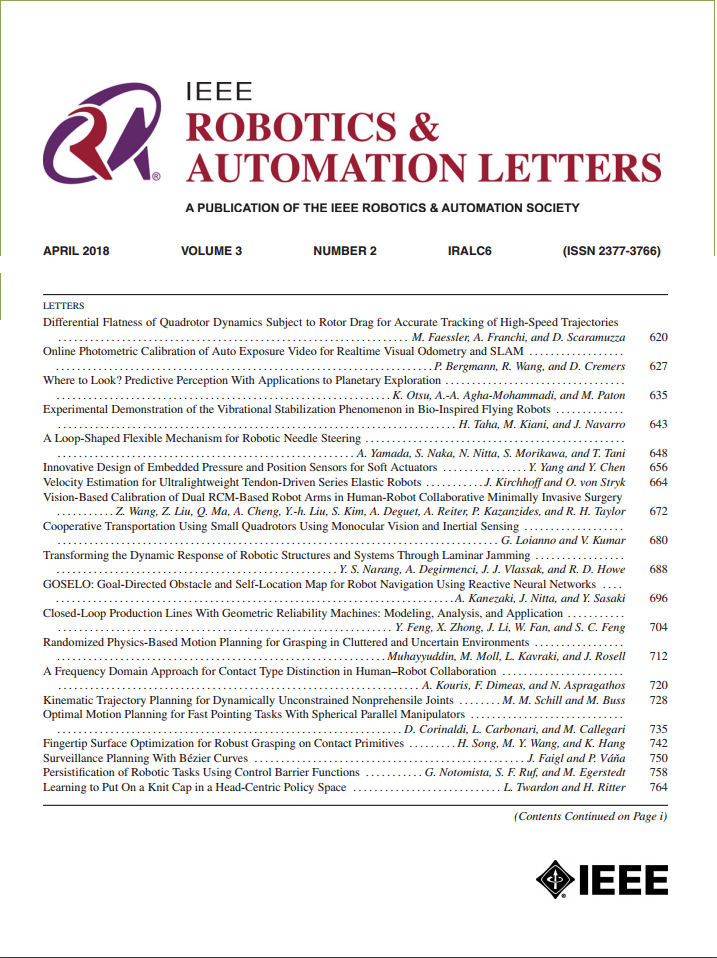Optimal Design of Integrated Aerial Platforms With Passive Joints
IF 5.3
2区 计算机科学
Q2 ROBOTICS
引用次数: 0
Abstract
The Integrated Aerial Platform (IAP) uses multiple quadrotor sub-vehicles, acting as independent thrust generators, connected to a central platform via passive joints. This setup allows the sub-vehicles to collectively apply forces and torques to the central platform, achieving full six-degree-of-freedom (6-DoF) motion through coordinated thrust and posture adjustments. The IAP's modular design offers significant advantages in terms of mechanical simplicity, reconfigurability for diverse scenarios, and enhanced mission adaptability. This letter presents a comprehensive framework for IAP modeling and optimal design. We introduce a “design matrix” that encapsulates key architectural parameters, including the number of sub-vehicles, their spatial configuration, and the types of passive joints used. To improve control performance and ensure balanced wrench generation capabilities, we propose an optimized design strategy that minimizes the condition number of this design matrix. Two distinct IAP configurations were optimally designed based on two typical application scenarios. The efficacy of the proposed optimization methodology was subsequently validated through comparative analysis against unoptimized platforms. Moreover, the full actuation capability of the IAP was empirically confirmed via extensive simulations and real-world flight experiments, which also demonstrated its operational performance through direct wrench control experiment.带被动接头的综合航空平台优化设计
集成空中平台(IAP)使用多个四旋翼子飞行器,充当独立的推力发电机,通过被动接头连接到中央平台。这种设置允许子车辆共同向中央平台施加力和扭矩,通过协调推力和姿态调整实现全六自由度(6-DoF)运动。IAP的模块化设计在机械简单性、不同场景的可重构性和增强的任务适应性方面提供了显著的优势。这封信提出了IAP建模和优化设计的综合框架。我们引入了一个“设计矩阵”,封装了关键的建筑参数,包括子车辆的数量、空间配置和使用的被动连接类型。为了提高控制性能并确保平衡的扳手生成能力,我们提出了一种优化设计策略,使该设计矩阵的条件个数最小化。基于两种典型应用场景,优化设计了两种不同的IAP配置。随后通过与未优化平台的对比分析验证了所提出的优化方法的有效性。此外,通过大量的仿真和实际飞行实验验证了IAP的全驱动能力,并通过直接扳手控制实验验证了IAP的操作性能。
本文章由计算机程序翻译,如有差异,请以英文原文为准。
求助全文
约1分钟内获得全文
求助全文
来源期刊

IEEE Robotics and Automation Letters
Computer Science-Computer Science Applications
CiteScore
9.60
自引率
15.40%
发文量
1428
期刊介绍:
The scope of this journal is to publish peer-reviewed articles that provide a timely and concise account of innovative research ideas and application results, reporting significant theoretical findings and application case studies in areas of robotics and automation.
 求助内容:
求助内容: 应助结果提醒方式:
应助结果提醒方式:


